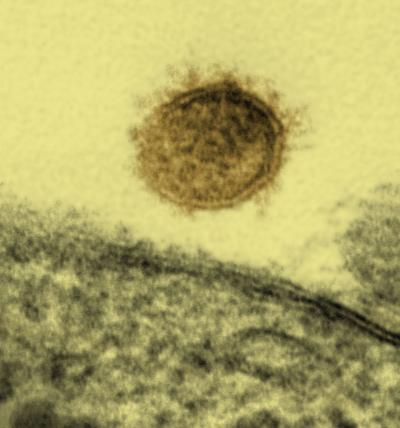NIH scientists establish monkey model of hantavirus disease

A sin nombre virus particle emerges from a cell. Credit: National Institute of Allergy and Infectious Diseases
People become infected with hantaviruses by inhaling virus from the urine, droppings or saliva of infected rodents. This infection can progress to HPS, a severe respiratory disease that was first identified in 1993 in the southwestern United States.
HPS attained global attention in the summer of 2012 when physicians diagnosed 10 cases—three of them fatal—in Yosemite National Park in California. The primary HPS agents are Sin Nombre virus in North America and Andes virus in South America. Since 1993, the Centers for Disease Control and Prevention has reported approximately 600 HPS cases, including 200 deaths, in the United States; case numbers for South America are not available.
In their study, NIAID scientists infected healthy deer mice with Sin Nombre virus obtained from descendants of wild deer mice. The researchers then exposed 10 rhesus macaques to the virus derived from the newly infected deer mice. Nine monkeys became infected and seven developed severe disease.
In the diseased macaques, researchers observed how and where the virus established infection, evaded the immune system and caused pneumonia. Of note, they report that, similar to hantavirus infection in people, the virus in the monkey model triggers a life-threatening immune response nearly two weeks after infection.
NIAID researchers aim to identify biological markers during that initial timeframe that may be useful for early diagnosis.
ARTICLE: Safronetz et al. Pathophysiology of hantavirus pulmonary syndrome in rhesus macaques. Proceedings of the National Academy of Sciences DOI: 10.1073/pnas.1401998111 (2014).
WHO: NIAID Director Anthony S. Fauci, M.D., is available for interviews. David Safronetz, Ph.D., of NIAID’s Laboratory of Virology, also is available.
CONTACT: To schedule interviews, please contact Ken Pekoc, (301) 402-1663, kpekoc@niaid.nih.gov.
NIAID conducts and supports research—at NIH, throughout the United States, and worldwide—to study the causes of infectious and immune-mediated diseases, and to develop better means of preventing, diagnosing and treating these illnesses. News releases, fact sheets and other NIAID-related materials are available on the NIAID Web site at http://www.niaid.nih.gov.
About the National Institutes of Health (NIH): NIH, the nation's medical research agency, includes 27 Institutes and Centers and is a component of the U.S. Department of Health and Human Services. NIH is the primary federal agency conducting and supporting basic, clinical, and translational medical research, and is investigating the causes, treatments, and cures for both common and rare diseases. For more information about NIH and its programs, visit http://www.nih.gov.
NIH…Turning Discovery Into Health®
Media Contact
All latest news from the category: Life Sciences and Chemistry
Articles and reports from the Life Sciences and chemistry area deal with applied and basic research into modern biology, chemistry and human medicine.
Valuable information can be found on a range of life sciences fields including bacteriology, biochemistry, bionics, bioinformatics, biophysics, biotechnology, genetics, geobotany, human biology, marine biology, microbiology, molecular biology, cellular biology, zoology, bioinorganic chemistry, microchemistry and environmental chemistry.
Newest articles

Superradiant atoms could push the boundaries of how precisely time can be measured
Superradiant atoms can help us measure time more precisely than ever. In a new study, researchers from the University of Copenhagen present a new method for measuring the time interval,…

Ion thermoelectric conversion devices for near room temperature
The electrode sheet of the thermoelectric device consists of ionic hydrogel, which is sandwiched between the electrodes to form, and the Prussian blue on the electrode undergoes a redox reaction…

Zap Energy achieves 37-million-degree temperatures in a compact device
New publication reports record electron temperatures for a small-scale, sheared-flow-stabilized Z-pinch fusion device. In the nine decades since humans first produced fusion reactions, only a few fusion technologies have demonstrated…





















